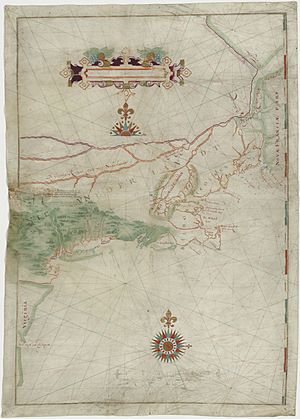Adriaen Block facts for kids
Adriaen (Arjan) Block (born around 1567 – died 1627) was a Dutch explorer, trader, and ship captain. He is famous for exploring the coast and river areas between what is now New Jersey and Massachusetts. He made four trips between 1611 and 1614, after Henry Hudson's journey in 1609.
Block might have named Block Island, Rhode Island. He also started early trade with the Native Americans. His 1614 map of his last trip was very important. It showed many places in the mid-Atlantic region for the first time. This map also first used the name "New Netherland" for the area.
He was the first European to enter Long Island Sound and the Connecticut River. He also figured out that Manhattan and Long Island are islands.
Contents
Adriaen Block's Early Life and Voyages
Adriaen Block lived in Amsterdam, even though he spent a lot of time at sea. He married Neeltje Hendricks van Gelder in 1603. They had five children together. Their home was called De Twee Bontecraijen ("The Two Hooded Crows").
Block started working in shipping in the 1590s. He carried wood from Northern Europe to Spain. For example, in 1596, he delivered Norwegian timber to Bilbao. He also sailed to the Dutch East Indies (now Indonesia) in 1601, returning in 1603.
In 1604, Block sailed to Cyprus to buy goods like rice and cotton. On his way home, near Lisbon, he found a ship from Lübeck that was returning from Brazil. Block had permission from Dutch authorities to capture ships from enemy countries. He took the ship and its cargo to Amsterdam. He made a lot of money from this, which likely helped him buy his house.
Exploring the New World
First Journeys to America (1611–1612)
After Henry Hudson met Native Americans in the Hudson Valley in 1609, Dutch traders in Amsterdam became interested. They saw the area as a good place to trade for beaver pelts. Beaver fur was very popular and valuable in Europe.
Another captain, Cornelis Rijser, returned successfully in 1611. Block and his fellow captain Hendrick Christiaensen came back in 1612. They brought furs and two sons of a native chief. Sailing to New Netherland took about ten weeks.
The Dutch government, called the States General, wanted to encourage more exploration. In 1614, they announced a rule. Explorers who found new lands or passages would get special rights. These rights would allow them to trade in the new areas for three years.
The Important 1614 Expedition
In 1613, Block began his fourth trip to the lower Hudson River. He sailed on a ship called the Tyger. Other ships joined him for trading. While docked near southern Manhattan, the Tyger accidentally caught fire and was destroyed.
During the winter, Block and his crew built a new ship. They got help from the Lenape people. This new ship was 44.5-foot (13.6 m) long and weighed 16 tons. They named it the Onrust, which means "Restless" in Dutch.
With the Onrust, Block explored the East River. He was the first European known to sail through the Hellegat, now called Hell Gate. He then entered Long Island Sound. As he traveled along the Sound, he found the Housatonic River, which he called "River of Red Hills." He also explored the Connecticut River. He sailed at least as far as where Hartford, the capital of Connecticut, is today.
Leaving Long Island Sound, he mapped Block Island, which is named after him. He also mapped Narragansett Bay. He might have named "Roode Eylandt" (Red Island) because of its red soil. At Cape Cod, he met up with another ship from his expedition. He left the Onrust behind and returned to Europe.
Life in the Colony and New Discoveries
Block's explorations helped lead to the future settlement of Connecticut. The first Dutch base in Connecticut was set up in the winter. This was difficult because the Connecticut River froze. Block sailed upstream and established the base that later became Hartford.
He is also said to have named Fishers Island (Vischer's Island). He named it after one of his shipmates. Even though this island is closer to Connecticut, it is part of Suffolk County in New York.
The New Netherland Company
When Block returned home, he created a map of his journey. He added all the information known at that time. Block's map was the first to call the area between English Virginia and French Canada "New Netherland". It was also the first map to show Long Island as an island.
On October 11, 1614, Block, Christiaensen, and twelve other merchants asked the States General for special trading rights. Their new company, the New Netherland Company, was given exclusive rights for three years. They could trade in the area between the 40th parallel north and the 45th parallel north.
After his return to Amsterdam in July 1614, Block never came back to the New World. In 1615, he became a Commissary-General. This meant he oversaw a group of ships sent to Spitsbergen for whaling. He continued sailing until he died in 1627. He was buried in Amsterdam's Oude Kerk next to his wife.
Legacy
- A large development on the Connecticut River in Hartford, Connecticut, is called "Adriaen's Landing" in his honor.
- A middle school in Flushing, Queens (New York City), is named after him.
- Block Island, off the coast of Rhode Island, is also named after him.
See also
 In Spanish: Adriaen Block para niños
In Spanish: Adriaen Block para niños



